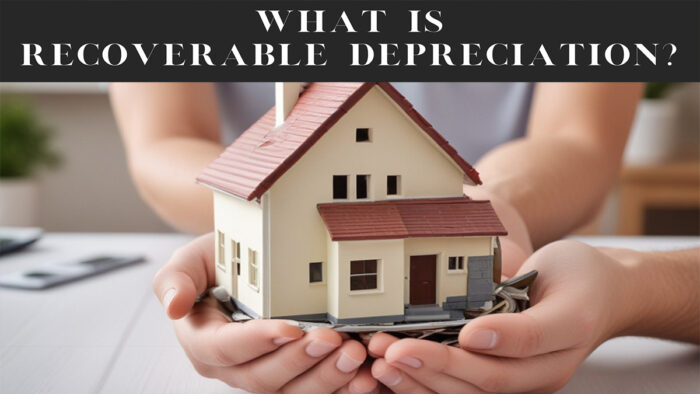When purchasing home insurance, you will be given the option to choose replacement coverage that covers the cost of damaged or stolen property or items. Part of the process of obtaining home insurance also includes recoverable depreciation.

If you seek comprehensive and detailed information about recoverable depreciation, you are in the right place. In this article, we aim to provide an overview of recoverable depreciation, including other valuable tips that would help broaden your knowledge.
What is Recoverable Depreciation?
Recoverable depreciation is the difference between the depreciated value of an item and the actual costs of repairing or replacing a damaged or stolen item. For instance, if the depreciated value of a stolen laptop is $900 and it would cost about $2,000 to get a new or similar model, the recoverable depreciation is $1,100.
How Is Recoverable Depreciation Calculated?
The first thing your insurance company does when you file a claim under replacement cost coverage is to calculate the actual cash value (ACV) of the damaged item. You can as well do the math on your own.
Actual Cash Value Reimbursement
In a situation where your property gets damaged or destroyed by a catastrophic event, your insurance company will appoint an insurance adjuster to assess and determine the actual cash value (ACV) of the property. This process of checking the damages incurred includes considering the depreciation, assessing the property’s age, life expectancy, and wear and tear.
For instance, if you purchased an item (a laptop, for example) three years ago for $2,000 and it gets damaged or stolen, your homeowner’s insurance adjuster will determine the general expectancy for the laptop, let’s say a maximum of five years.
Since the laptop was three years old (60% of the expected lifespan), it depreciated by $1,200 (60% of $2,000 = $1,200). An actual cash value payment would be $800 ($2,000 minus. $1,200 depreciated value = $800 ACV).
Please note that your insurance deductible also applies to a claim, and it would have an adverse effect on your insurance check for actual cash value reimbursement.
How to Make a Recoverable Depreciation Claim
If the need ever arises for you to make a recoverable depreciation claim, there’s a process you have to follow. We have helped to outline the steps on how to make a claim below:
- Notify your insurance company as soon as you notice the damage done.
- Gather all relevant documentation, such as photographs, receipts, or police reports (for theft claims).
- Once you’ve gathered your documents, fill out and submit your claim form along with your supporting documents.
- Wait for your insurance company to process the claim. Once it is approved, you will receive the first payment for the item’s actual cash value.
- Afterwards, you can either repair or replace the item that was damaged.
- Submit the receipt to your insurance company.
- Then, you will receive your second payment for recoverable depreciation.
If your insurance company’s assessment doesn’t really sit well with you, there’s no harm in negotiating the value of your recoverable depreciation. You can request a clear breakdown of how each item is being evaluated, then opt for a line item breakdown rather than a lump sum.
Who Gets a Recoverable Depreciation Insurance Check?
A recoverable depreciation payment is issued to policyholders whose nature of claim is reasonable and included in the policy. For instance, if you’re repairing or replacing an appliance or piece of furniture in your home, the payment will be issued to you.
But if your home is damaged, then your mortgage company will be listed on the insurance check simply because it has a legal interest in your home. It is important to review the terms and conditions attached to filing a claim for recoverable depreciation to get a better understanding of how it works, including its limitations.
Factors That Influence Recoverable Depreciation Payment
- If the actual cost of the replacement item is below the value of your original item.
- If you decide not to repair or replace an item. In this case, you won’t receive a recoverable depreciation check, but you will receive a check for the item’s cash value.
- Filing a claim for an item that doesn’t depreciate. If you file a claim for an item that doesn’t appreciate in value, you will most likely not get a second check.
- If you missed the deadline for the claim. This is also another factor that determines payment. There are certain states that specify the period of time you are coveted to make a claim for recoverable depreciation. This timeline ranges from six months to a year; it largely depends on the state in which you reside and your insurance company.
In Florida, policyholders must file a claim for recoverable depreciation within six months of their ACV payment; it could also be after there’s a final court order that they declare your right to replacement cost.
Is Recovery Depreciation the Same as Replacement Cost?
Although the two work in a similar manner, they are not exactly the same. Replacement costs simply cover the cost of repairing or replacing your property on a covered claim without considering depreciation.
On the other hand, recoverable depreciation is the difference between the item’s depreciated value and the actual cost of replacing it. Also, depreciation recovery takes wear and tear into account; all you have to do is notify your insurance company and get your claim approved.



